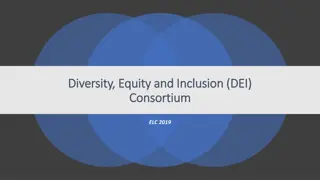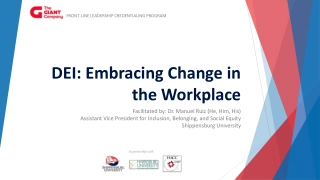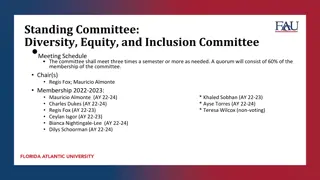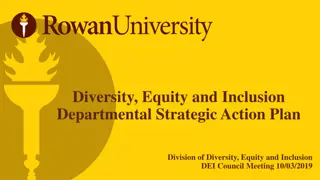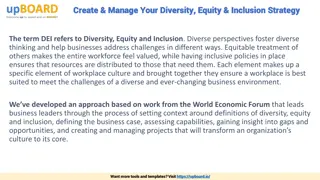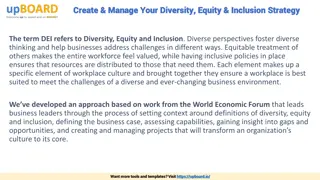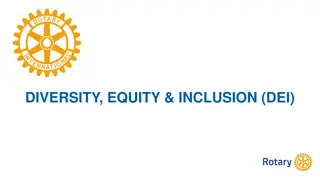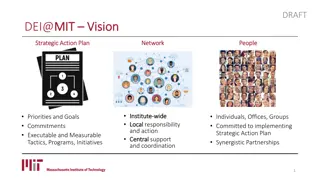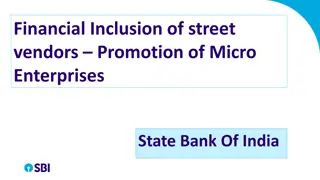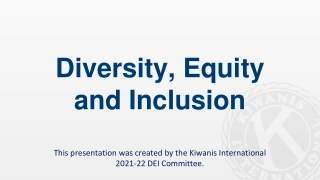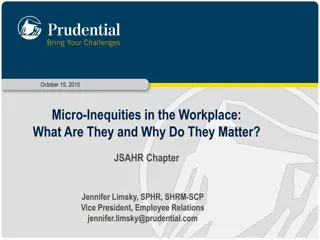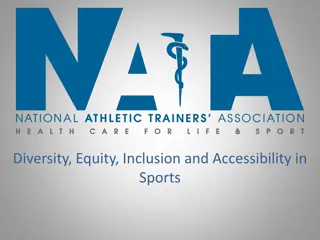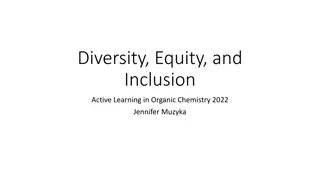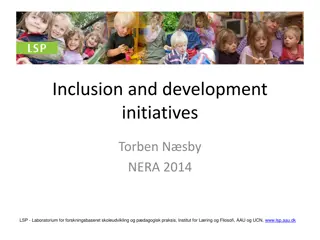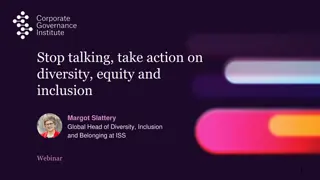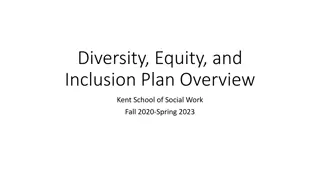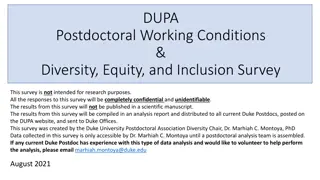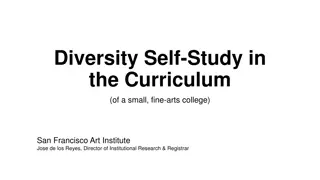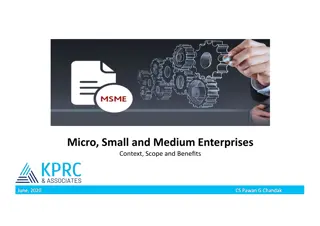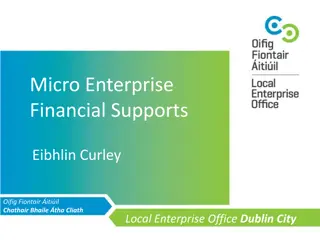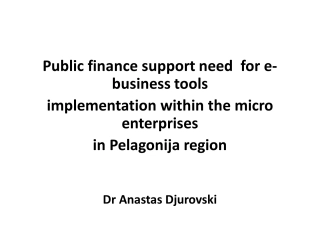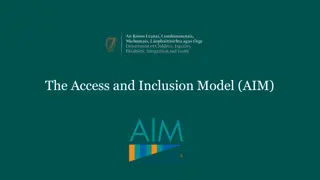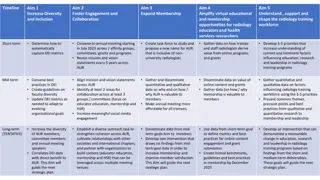Integrating Diversity, Equity, and Inclusion (DEI) in Micro-enterprises: A Practical Guide
Embrace the benefits of DEI in micro-enterprises through this comprehensive guide promoting creativity, talent attraction, productivity, and social responsibility. Learn about the significance of diversity, equity, and inclusion in fostering innovation, attracting top talent, and improving decision-making processes. Utilize this resource to create a more inclusive workplace environment while advancing the long-term success of your micro-enterprise.
Download Presentation

Please find below an Image/Link to download the presentation.
The content on the website is provided AS IS for your information and personal use only. It may not be sold, licensed, or shared on other websites without obtaining consent from the author. Download presentation by click this link. If you encounter any issues during the download, it is possible that the publisher has removed the file from their server.
E N D
Presentation Transcript
OPSIZO WP3 Operational Tool Practical Guide to DEI integration for micro-enterprises Developed by IHF asbl The European Commission's support for the production of this publication does not constitute an endorsement of the contents, which reflect the views only of the authors, and the Commission cannot be held responsible for any use which may be made of the information contained therein. Legal description Creative Commons licensing: The materials published on the Opsizo project website are classified as Open Educational Resources' (OER) and can be freely (without permission of their creators): downloaded, used, reused, copied, adapted, and shared by users, with information about the source of their origin.
Introduction DEI (Diversity, Equity, and Inclusion) is crucial in all workplace dimensions, including microenterprises. Promoting an inclusive and diverse workplace is ethically imperative and can lead to positive business outcomes. The guide aims to provide microenterprises with a comprehensive framework for effectively integrating DEI into their operations. Motivation stems from recognizing that DEI offers numerous benefits, including improved company culture, creativity, talent attraction, broader customer base and reduced legal risks. This guide is designed to assist microenterprises in cultivating a more inclusive workplace and leveraging the benefits of promoting diversity, equity and inclusion. DEI is not only an ethical imperative but can also contribute to the long-term success of microenterprises.
Benefits of DEI in organisations FOSTERS CREATIVITY AND INNOVATION A diverse workforce brings a range of perspectives and experiences, creativity and innovation organisation. promting within the ATTRACTS AND RETAINS TOP TALENT Companies that prioritise DEI are more attractive to top talent, leading to higher retention rates and a more engaged workforce. INCREASES PRODUCTIVITY AND PROFITABILITY A diverse and inclusive workforce leads to increased employee satisfatction, productivity and profitability IMPROVES DECISION-MAKING A diverse team brings a wider range of experiences and perspectives, which leades to better decision-making and problem-solving. PROMOTES SOCIAL RESPONSABILITY Organisations that prioritise DEI contribute to creating a more just and equitable society, promoting social responsibility and enhancing their reputation.
What is DEI? The recognition that every individual, family, community, and societal group possesses unique qualities that differentiate them from others. These distinctions include factors such as gender, race, age, beliefs, socio-economic status, abilities, and ideologies. Diversity Equity Equity refers to the concept of ensuring that each individual has equal access to the same opportunities and resources, regardless of their differences. Inclusion The act of incorporating someone or something as part of a group. This means that everyone, including those from diverse cultural backgrounds, races, religions, and socio-economic statuses, is empowered, included and trusted.
DEI and SDGs End all forms of discrimination against all women and girls everywhere. Eliminate all forms of violence against women and girls in both public and private spheres, including human trafficking, sexual violence, and other harmful practices. Ensure the full and effective participation of women and equal opportunities for leadership at all decision-making levels in political, economic, and public life.
DEI and SDGs Full and productive employment and decent work for all, including women and young people, as well as equal pay for work of equal value.
DEI and SDGs Empower and promote the social, economic, and political inclusion of all, irrespective of age, sex, disability, race, ethnicity, origin, religion, or economic or other status.
DEI and SDGs Promote the rule of law at the national and international levels and ensure equal access to justice for all. Ensure responsive, inclusive, participatory, and representative decision-making at all levels. Provide legal identity for all, including birth registration.
DEI and SDGs Encourage and promote effective public, public-private, and partnerships, building on the experience and resourcing strategies of partnerships. civil society
DEI Policies These policies are typically developed to ensure fair treatment, equal opportunities, and a welcoming environment for all employees, regardless of their background, identity, or characteristics. They may include: Promotion of Flexible Work: allow employees to better balance work with family and personal life. This can be particularly important for employees with family responsibilities. Anti-Discrimination and Anti-Harassment: Clearly defining and condemning discrimination, harassment, and retaliation in the workplace and providing procedures for reporting and addressing such incidents. Promote a culture in which employees feel safe to report discrimination or harassment. Provide clear procedures for handling such reports confidentially and effectively. Strive to create a diverse workforce that reflects the community in which you operate. This may include hiring individuals from diverse ethnic, cultural, gender, and ability backgrounds. Provide development and training opportunities for all employees, regardless of their differences. This can help reduce inequalities in growth opportunities. Equal employment opportunities to all individuals and prohibiting discrimination based on factors such as race, gender, age, religion, disability, sexual orientation, or gender identity.
DEI in hiring and selection Review your hiring processes to ensure they are inclusive. Advertise job openings to reach a wide range of candidates and eliminate any bias from the selection process. Diverse job posting: use inclusive language in job postings to attract a wide range of candidates and avoid gender- specific terms and focus on qualifications and skills. Blind resume screening: remove personally identifiable information such as names, photos and addresses from resumes during the initial screening process to reduce unconscious bias. Evaluate candidates solely on their qualifications and experience. Structued interviews: develop standardised interview questions that assess canidates based on job-related skills and competencies. Train interviewers to avoid asking biased or discriminatory questions. Trasparency in selection criteria: cleary define the criteria used to evaluate candidates and communicate these criteria to all involved in the hiring process Unconscious bias training: provide training to all employees involved in the hiring process to recognise and mitigate unconscious bias. This training can help ensure fair treatment of all candidates. Diversity in sourcing: actively seek out candidates from diverse backgrounds throygh a variety of channels, including social media, professional networks and referrals.
DEI Performance Assessment and Feedback It measures progress in ensuring a more diverse and inclusive workplace, gathers data, sets goals, offers feedback, and takes corrective actions to promote diversity and equality within the organization. Establish a confidential reporting system for employees to report incidents of discrimination, harassment, or bias without fear of retaliation. Define key performance indicators (KPIs) related to DEI and track progress over time. Metrics could include diversity in recruitment, promotion rates, or employee satisfaction. Conduct regular DEI surveys among employees to gauge their perceptions and experiences related to diversity, equity, and inclusion within the workplace.
DEI Matrix FOR The Winner The Novice Committed advocates, allies and experts in the space, they live, eat and breathe DEI. They know a lot about the issues and actively work toward change. Well-intentioned yet uninformed, their heart are in the right place. They sometimes express ignorant ideas, unknowingly contributing to problems they want to see solved. UNINFORMED INFORMED The Onlooker The Zealot Largely indifferent, they do nothing to advance progress but little to actively hinder it, either. DEI? Huh? They are busy and have not really throught about it . They think DEI efforts are a waste of time and money. Confident that they are biased for a reason , they do not intend to change their mind. AGAINST
Community Engagement Involve the company in the local community through volunteering activities, sponsorships, and collaborations with organizations that promote DEI. Collaborate with community leaders and influencers to ensure your initiatives align with community goals. Encourage employees to volunteer their time and skills to local community organizations that support DEI initiatives. Sponsor and actively participate in local DEI- related events, such as diversity fairs, cultural festivals, or workshops. Prioritise sourcing products and services from local businesses owned by individuals from diverse backgrounds. Provide paid time off or flexible scheduling to facilitate employee participation in community service. Actively seek out and support minority-owned enterprises in your supply chain.
Inclusive Communication Use inclusive language in all company communications, including emails, internal documents and websites. Avoid the use of expressions or stereotypes that may be offensive. Be mindful of cultural differences when communicating with a diverse audience. Use respectful language when referring to individuals with disabilities. Gender neutral language Eliminate gender, race or age-related sterotypes in your communications Be aware of and respectful toward various religious holidays and observances. Accessibility-Friendly language
Accessibility and Inclusion support Ensure that the workplace is accessible to all employees, including those with disabilities. This may require physical or technological adaptations. Designate at least one of the bathrooms as a "unisex", allowing anyone to use them regardless of gender. Ensure signage is clear and includes universal symbols to represent gender- neutral bathrooms. Ensure that at least one restroom is accessible to people with disabilities. Install accessible visual and audible alarm devices to ensure that everyone can be informed in case of an emergency. Provide assistive technologies, such as touchscreens with audio for accessing controls and information. Feedback and continuos improvement
The European Commission's support for the production of this publication does not constitute an endorsement of the contents, which reflect the views only of the authors, and the Commission cannot be held responsible for any use which may be made of the information contained therein. Legal description Creative Commons licensing: The materials published on the Opsizo project website are classified as Open Educational Resources' (OER) and can be freely (without permission of their creators): downloaded, used, reused, copied, adapted, and shared by users, with information about the source of their origin.




